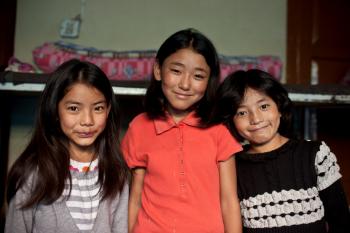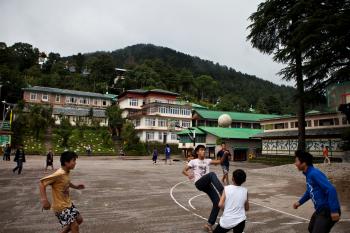Struglling to make ends meet

Good friends at the village (photo: C. Ashleigh).
Dharamsala plays a central role for Tibetans. It is well known for being the home of the Dalai Lama since 1959. Likewise, the area is home to the largest number of Tibetans in India – of the estimated 140,000 Tibetans living outside of Tibet, autonomous region of China, over 10,400 people live in Dharamsala. Many of these people have been born and raised in India. Children from Tibet, autonomous region of China are often sent here by their parents.
Many tourists, both from other areas of India and from abroad, come to Dharamsala in order to visit the religious temples and monasteries, and experience the Tibetan way of life. The majority of the local people are involved in the tourist industry by running restaurants, hotels and shops selling handicrafts.
Due to the high levels of unemployment, there is a growing number of families who struggle to make a living. Those who are most likely to be poor are the old and infirm and families with children.
Supporting children from Tibet, autonomous region of China
In 1971, what was initially a make-shift children's home was turned into the first Tibetan Children’s Village community in Dharamsala. The programmes run in the region have expanded in the last four decades in order to meet the increasing needs of the Tibetan population arriving in India. All the children in families have lost parental care; while some children have no living parents, others have parents who live in Tibet, autonomous region of China as well as in other locations throughout India, or have moved abroad.
.
.
What Tibetan Children’s Villages does in Dharamsala

Boys enjoying a game of football together (photo: C. Ashleigh).
Due to the large numbers of children who have lost parental care, homes consist of up to 30 children who are cared for by a Tibetan mother or couple. In order to allow carers to spend more time looking after the needs of the children, all the meals are prepared at a central kitchen and then distributed to the homes. In addition, there are also separate homes where babies are looked after.
Young adults join the youth programme while they start vocational training or go on to higher education. With the support of qualified professionals they are guided through this new stage of their lives.
The medical centre provides health care to those living in the village and it is also open to the local community. There is a large vocational training centre which offers courses in arts and handicrafts, so that people can generate an income.
Young children go to kindergarten and then to the school which offers primary and secondary schooling for over 1,900 children.